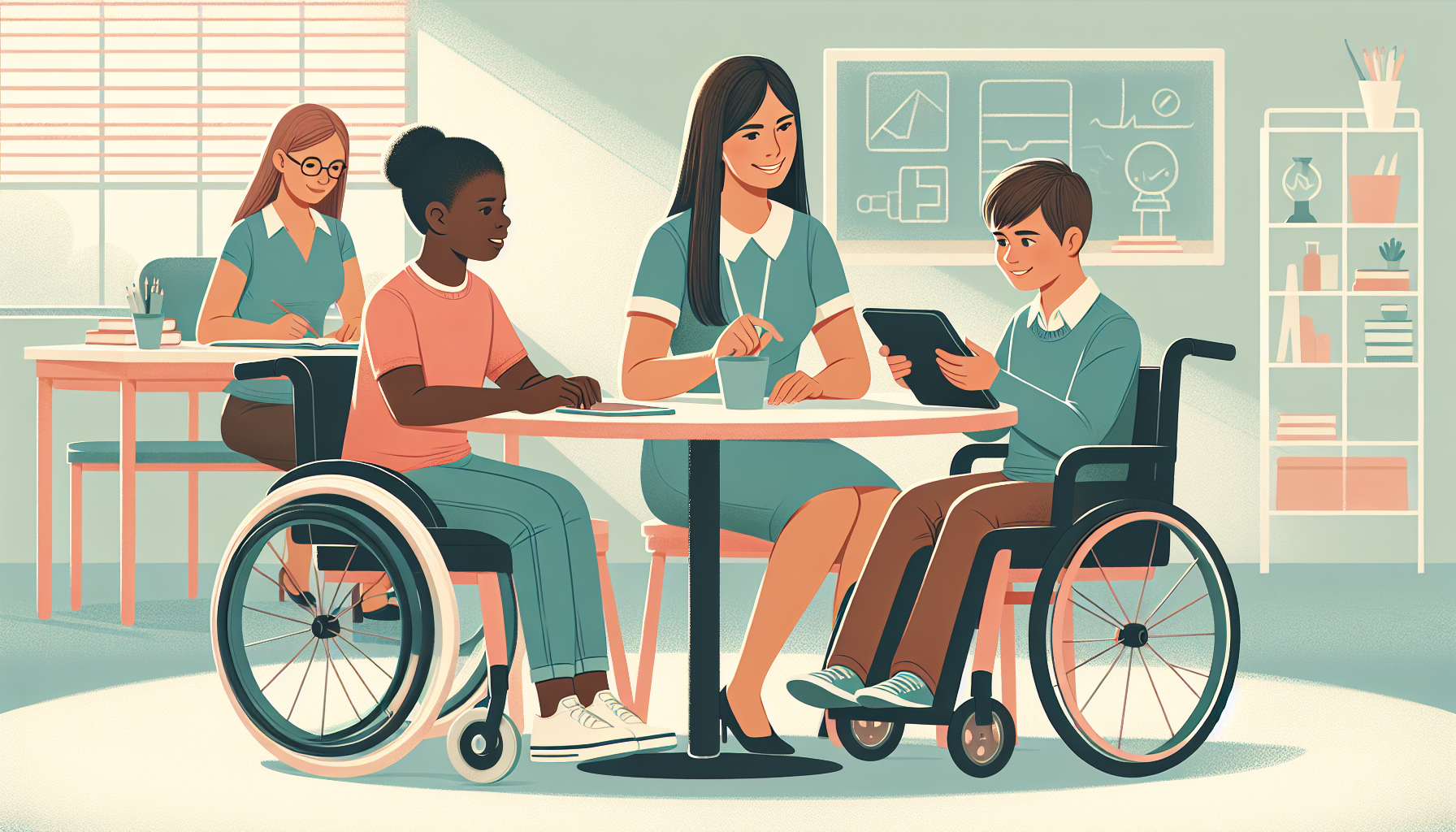Teaching students with disabilities can feel overwhelming. You might wonder how to reach each unique learner and create an engaging classroom where everyone thrives. It’s totally normal to feel that way; after all, every student deserves the chance to shine, right?
But hang tight! In this guide, we’re diving into effective strategies that can make your teaching experience a whole lot smoother and your students’ learning a lot brighter. If you stick with me, you’ll discover practical approaches that can transform your classroom into a truly inclusive space.
We’ll cover everything from understanding different disabilities to using assistive technology and building strong relationships with families. Together, let’s unlock the potential of every student and create a vibrant learning environment!
Key Takeaways
- Build supportive relationships with students to increase engagement and learning outcomes.
- Understand different disabilities to tailor your teaching strategies effectively.
- Create an inclusive classroom with accessible spaces and diverse materials that reflect all backgrounds.
- Utilize Individualized Education Plans (IEPs) by collaborating with families and regularly updating goals.
- Adapt teaching methods to accommodate various learning styles and use multi-sensory approaches.
- Incorporate assistive technology to empower students and enhance their learning experiences.
- Encourage collaboration among educators, families, and peers to create a strong support network.

Effective Strategies for Teaching Students with Disabilities
Teaching students with disabilities effectively requires a combination of understanding, adaptation, and creativity. The journey of each student is unique, influenced by their specific needs and strengths.
One key strategy is to build supportive relationships where trust can flourish. When students feel valued and understood, their willingness to engage increases, leading to better learning outcomes.
Regular training and resources for teachers can significantly impact their ability to connect with and teach these students. Utilizing workshops and online resources, such as effective teaching strategies, can enhance their skills and awareness.
Understanding Different Types of Disabilities
Knowing the specific disabilities that students might have is fundamental to providing appropriate support. Approximately 7.5 million students ages 3-21 are served under the Individuals with Disabilities Education Act (IDEA), making up 15% of public school enrollment.
Among these, specific learning disabilities, like dyslexia, account for 32%, while speech or language impairments represent 19%. Understanding the nuances of each disability helps educators tailor their approach.
For example, students with autism may benefit from structured routines and visual aids, while those with attention deficit hyperactivity disorder (ADHD) may thrive in engaging, interactive learning environments. Recognizing these differences is the first step in creating effective strategies.
Creating an Inclusive Classroom Environment
An inclusive classroom is one where every student feels welcomed and supported. Designing such an environment starts with physical space—ensure that classrooms are accessible, with room for mobility devices and quiet areas for students who may need a break.
Incorporating diverse materials that reflect all students’ backgrounds fosters connection and understanding. For instance, include books that represent various cultures and abilities. This helps all students to see themselves in the learning material.
Engage students in activities that promote teamwork and collaboration, allowing them to learn from each other. Activities like group projects or peer tutoring make everyone feel included and valued.
Utilizing Individualized Education Plans (IEPs)
Individualized Education Plans (IEPs) are central to supporting students with disabilities. An IEP outlines specific educational goals for each student based on their unique needs, making it essential for teachers to collaborate with families and specialists.
Regularly reviewing and updating each student’s IEP ensures that the goals remain relevant and achievable. This collaborative approach creates a dynamic learning experience catered to the student’s evolving needs.
When implementing IEPs, involve students in the process. Explain their goals in relatable terms and encourage their input on how they learn best. This not only empowers students but also promotes accountability in achieving their objectives.

Adapting Teaching Methods and Materials
Adaptability is key when teaching students with disabilities. Every student learns differently, so it’s essential to modify your teaching methods and materials to meet diverse needs.
Start by assessing each student’s learning style. Some may prefer visual aids, while others might benefit from hands-on activities. For example, using graphic organizers can help students with learning disabilities process information more effectively.
Incorporating multi-sensory approaches can make learning more engaging. Techniques like using tactile objects or incorporating music and movement can make a significant difference.
Don’t shy away from breaking lessons into smaller, manageable steps. This not only helps maintain focus but also allows for more frequent checks on understanding.
Utilize tools that support diverse learning needs. Resources like adapted books or leveled texts ensure that all students can access the curriculum at their own level. Consider exploring effective teaching strategies that emphasize differentiation.
Incorporating Assistive Technology
Assistive technology can empower students with disabilities by providing them with the tools to succeed. From text-to-speech apps to communication devices, the right technology can bridge gaps in learning.
Begin by identifying the specific challenges your students face. For instance, students with dyslexia may benefit from audio books or word prediction software. Others with physical impairments might need specialized keyboards or adaptive software.
Regularly introduce new technology to your classroom. This includes exploring options such as interactive whiteboards or tablets that offer educational apps tailored to various disabilities.
Ensure that both students and their families are involved in the decision-making process regarding assistive technology. Providing training sessions for parents can help reinforce these tools at home.
Lastly, continuously assess the effectiveness of the technology being used. Regular feedback from students can guide adjustments and ensure that their needs are consistently met.
Encouraging Collaboration and Support
Collaboration is essential in creating a supportive learning environment. Engaging other educators, therapists, and families can help create a network of support around each student.
Start by communicating openly with special education teachers. Their insights can provide valuable strategies for managing the classroom and addressing specific needs.
Additionally, consider forming support groups among teachers to share experiences and resources. These collaborative efforts can lead to a greater understanding of different disabilities and effective teaching methods.
Encourage peer support in the classroom as well. Pairing students with and without disabilities in group work can foster relationships and build empathy, helping to create a more inclusive atmosphere.
Don’t forget to involve families in the conversation. Regular communication through newsletters or family workshops can help parents feel connected and informed about their child’s progress.
Ultimately, a collaborative approach can significantly enhance the support network for students with disabilities, making learning a shared journey.

Implementing Positive Behavior Support
Positive Behavior Support (PBS) is a proactive approach to help students adopt positive behaviors while reducing challenging ones.
The first step is to clearly define and teach the expected behaviors in your classroom.
Create a set of classroom rules that are straightforward and easy to follow.
For instance, rather than saying “no running,” try “walking feet.”
Ensure that these expectations are consistently reinforced throughout the school year.
Using positive reinforcement, like praise or small rewards, can encourage students to exhibit desired behaviors.
Be sure to use specific feedback.
Instead of just saying “good job,” try, “I really appreciate how you raised your hand before speaking.”
If challenging behaviors arise, focus on understanding their underlying causes.
Observe the contexts and triggers that lead to such behaviors and address those specific issues.
Involving the student in discussing their behaviors and possible solutions can foster accountability and help them feel more invested.
Monitoring Progress and Adjusting Strategies
Monitoring progress is essential to ensure that the strategies in place are working effectively for each student.
Begin by setting clear, measurable goals for your students based on their IEPs and individual learning needs.
Regular assessments can help track their growth and provide insights into which approaches are effective.
Keep feedback loops short and frequent, allowing you to make timely adjustments to your teaching methods.
Using tools like progress monitoring charts can visualize students’ advancements and areas needing improvement.
Don’t hesitate to communicate openly with the student about their progress.
They might have insights on what works best for them which can inform future strategies.
If a particular approach isn’t yielding results after sufficient time, be ready to adapt.
Try different instructional methods or materials until you find the right fit for that student.
Involving families in this process can provide additional support and strategies outside school.
Building Strong Relationships with Students and Families
Fostering strong connections with students and their families lays the foundation for a supportive learning environment.
Take the time to get to know your students as individuals.
Simple gestures like greeting them at the door or asking about their interests can go a long way.
When families feel engaged and valued, they are more likely to contribute positively to their child’s education.
Hold introductory meetings at the beginning of the school year.
Encourage open lines of communication through regular updates, newsletters, or informal check-ins.
Use technology to your advantage.
Consider setting up a class website or communication app where families can stay informed about events and their child’s progress.
Invite families to participate in classroom activities or volunteer opportunities.
This involvement builds a sense of community and partnership that supports the student’s education.
Providing Professional Development for Educators
Ongoing professional development is vital for educators working with students with disabilities.
Encourage participation in workshops and training opportunities focused on inclusive teaching strategies.
Explore programs that focus on specific disabilities like autism or ADHD to deepen understanding.
Creating a culture of continuous learning can empower teachers to share ideas and collaborate.
Consider peer observations as a way to learn from one another.
Teachers can benefit immensely from seeing different teaching styles and strategies in action.
Create opportunities for discussion and reflection within your staff.
Regular team meetings can allow teachers to share successes as well as challenges they face.
Look out for online courses or webinars that provide flexible learning options.
Many organizations offer resources that can fit into busy schedules while still enhancing skills.
FAQs
Common types of disabilities include Specific Learning Disabilities (e.g., dyslexia), Autism Spectrum Disorder, Intellectual Disabilities, and Attention Deficit Hyperactivity Disorder (ADHD). Each disability presents unique challenges that require tailored teaching strategies.
To create an inclusive classroom, promote acceptance and understanding among students, provide flexible seating arrangements, and adapt activities to accommodate various needs. Encourage collaborative learning to foster peer support and inclusivity.
An Individualized Education Plan (IEP) is a personalized education plan designed to meet the unique needs of a student with disabilities. It outlines specific goals, accommodations, and support services to facilitate effective learning.
Assistive technology can be incorporated by using tools like text-to-speech software, speech recognition programs, and interactive apps. These technologies support diverse learning needs and enhance student engagement by making learning accessible.
